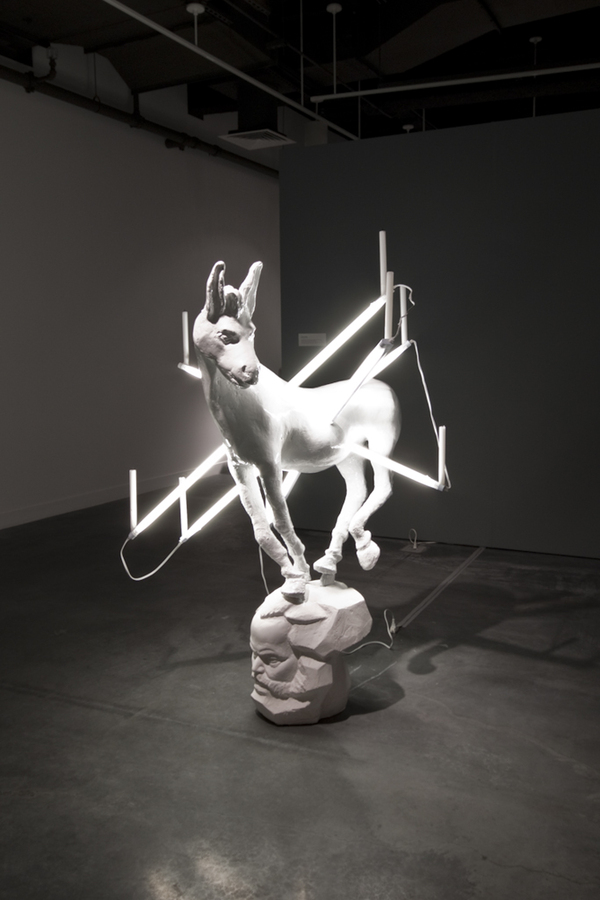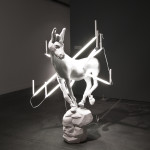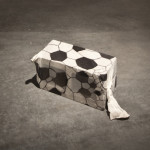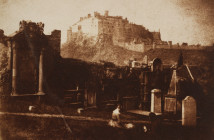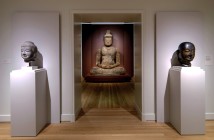Humor is a funny thing – sometimes. It can make you laugh, it can make you chuckle or it may repulse you. It may be silly, graphic, subtle, and offensive. Sometimes it is loud, at other times it’s clever, and there are times when it is not funny at all, but draws you in nonetheless.
The title for the exhibition “Face on the Bar Room Floor – the humor show,” currently on view at the Chace Center at the RISD Museum, is taken from a 1914 silent movie in which Charlie Chaplin, portraying an artist devastated by the loss of the woman he loves, uses slapstick humor to express a serious and common human experience – heartbreak.
The curators of the exhibition, Laura Swanson and Colin Williams, both graduate students in the Digital Media department at RISD, set out to examine the use of humor in art. They posed the questions: “How do artists use humor in their work?” and “Can art be simultaneously funny and analytical?” In an attempt to answer those questions they selected the works of twenty-two students who employ different kinds of humor to convey their ideas. Two of the most compelling pieces exhibited are Dolly Partonby Carter Bryant and Carlos Mencia Mimic by Jamie Goldstein, two videos in which female artists are playing with gender roles by impersonating men.
Carter Bryant must have watched a lot of YouTube videos about hobby taxidermy in preparation for her portrayal of a male DIY taxidermist: sitting in his basement late at night, drinking beer, smoking, spitting ’n’ cussin’ with a southern drawl, clad in plaid over a military T-shirt, toting a rifle, and the scene complete with photographs of nude women. He walks the viewer through the process of preparing a pink teddy bear to be stuffed and outfitted with a pair of antlers -- or as he calls it, a ‘big rack’-- to create ’Dolly Parton’, the name he has given his creation. ‘Dolly’ is displayed in a glass case in the gallery but, although elevated to art object in the context of the museum, the object remains secondary to the video exposing its underlying sexist attitudes.
Jamie Goldstein explores sexism disguised as humor in her role reversal by imitating a misogynistic comedy routine by Carlos Mencia in which he tries to explain the difference between men and women and their different attitudes towards sex. Interrupted with images of Goldstein as her own audience, the routine underscores the assumptions of the original comedian’s shtick, which becomes hilarious through the unveiling of its absurdity when performed by a woman. Goldstein’s revision is highly entertaining while simultaneously questioning the purpose of the original performance.
Very direct humor is at play in Taehee Kim’s piece Hello, a disc player set flush into the wall, that opens to varying degrees when approached. The work is a silly, practical joke, taking an everyday object out of its original context and animating it. I observed the disc player surprise an unsuspecting gallery visitor as he was walking by, much to the entertainment of the other visitors.
Joshua Webb toys with absurdity by putting a horse on top of a bust of Karl Marx, replete with neon-lit candle holders to create an all white sculpture. Titled Somewhere in Between, the work is a playful romp of the incongruous.
The photographs of Alex Arzt and Michael Mergen come across as sophisticated, multilayered, visual jokes. Arzt photographed a Capuchin monkey sitting on a blanket patterned with large images of huskies, while Mergen’s Landscape #201 portrays an array of religious statues chained to the ground in a snowy field against an intensely blue sky. The works seem to have been captured by eyes with a sense for narrative and the visually jarring.
Tom Zé, a “pretend” soccer ball by Rubens Ghenov made from a concrete block stuffed in a stocking and embellished with hand-drawn pattern, is funny on one level while providing social commentary about kids growing up in poverty and making their own soccer balls to play the game. Except here, the ball will never roll on any field.
Jason Huff’s extra large onion displayed in the foyer, entitled I want to cry for a hundred years, is making a strong reference to sculptures by Claes Oldenburg, the master of manipulating scale. The result is lighthearted and easy to relate to in that “look mom, a gigantic onion” way.
Upon first inspection, Jenny Lee’s colored composite drawings, using ballpoint pen just seem to be a hilarious gender mix up: a guy with a beard and Farrah Fawcett-esque hair until you realize it’s Fawcett’s hair combined with Michael Jackson nose and facial features of Patrick Swayze, David Carradine and Billy Mays -- all celebrities who died in 2009. Suddenly the focus shifts and the story is about death while at the same time questioning the role of celebrities and their worship as part of popular culture.
All together, the exhibition is steeped in references to popular culture with many pieces attempting to provide commentary about it. Unfortunately, some of the works remain similarly bland as their sources, the TV and the Internet.
Dylan Hayes’ Stephen Quire Forever, is the reenacting of a popular YouTube video about a teenager having an extended temper tantrum because he is not allowed to play video games. Lacking understanding of the appeal of the original video, I failed to see any potential humor or commentary in the video exhibited except to question the utter absurdity of airing this on YouTube in the first place.
While some of the work remains self-conscious and overly concerned with the role of the artist rather than focus on creating art that is engaging, many pieces in the exhibit are humorous and succeed in drawing the viewer in.And, going back to the question posed by the curators at the outset: yes, art can be analytical AND funny, with humor being an effective tool available to the artists to communicate ideas and engage the viewer, sometimes resulting in out-right laughter and at other times eliciting just a quiet smile form their audience.
- Joshua Webb, SOMEWHERE BETWEEN: Disco Donkey on Fire & Do Donkeys Bleed Blue Blood in Space, Styrofoam, plaster, epoxy resin, fluorescent lights, Karl Marx’s severed head, candles extinguished by institutional policy, 2010.
- Michael Mergen, Landscape #201, Archival Pigment Print, Edition 1 of 3, 2010.
- Rubens Ghenov, Tom Zé, cinder block, ink, pantyhose, 2009.
Jamie Goldstein's Carlos Mencia Mimic on Youtube.
"Face on the Barroom Floor" was exhibited April 22 through June 6, 2010 in the Gelman Gallery, Chace Center, Rhode Island School of Design.
All images are courtesy of the artists and RISD.

